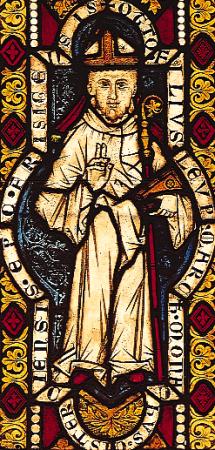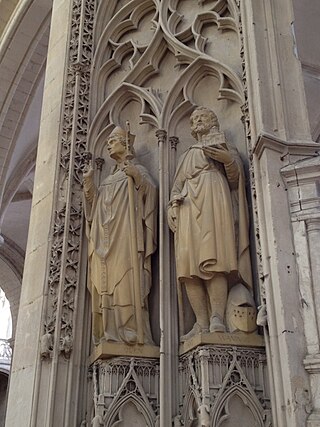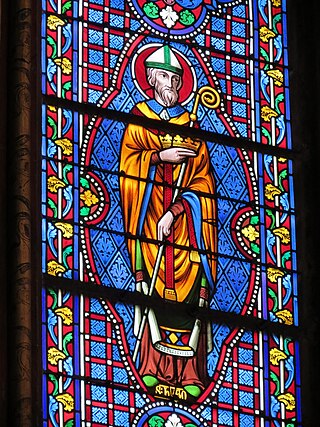Thomas Walsingham was an English chronicler, and is the source of much of the knowledge of the reigns of Richard II, Henry IV, Henry V and the latter reign of Edward III depicting the decline of the state of affairs of the English. He also documented the careers of John Wycliff and Wat Tyler.

Otto of Freising was a German churchman of the Cistercian order and chronicled at least two texts which carries valuable information on the political history of his own time. He was the bishop of Freising from 1138. Otto participated in the Second Crusade; he lived through the journey and reached Jerusalem, and later returned to Bavaria in the late 1140s, living for another decade back in Europe.

Sigebert of Gembloux was a medieval author, known mainly as a pro-Imperial historian of a universal chronicle, opposed to the expansive papacy of Gregory VII and Pascal II. Early in his life he became a monk in the Benedictine abbey of Gembloux.

Audoin, venerated as Saint Audoin, was a Frankish bishop, courtier, hagiographer and saint. He authored Vita Sancti Eligii which outlines the life and deeds of Eligius, his close friend and companion in the royal court and the Church.

Fontenelle Abbey or the Abbey of St. Wandrille is a Benedictine monastery in the commune of Rives-en-Seine. It was founded in 649 near Caudebec-en-Caux in Seine-Maritime, Normandy, France.

Hugh was the son of Duke Drogo of Champagne and his wife Anstrudis. He entered the church and became archbishop of Rouen in 722.

John of Wallingford, also known as John de Cella, was Abbot of St Albans Abbey in the English county of Hertfordshire from 1195 to his death in 1214. He was previously prior of Holy Trinity Priory at Wallingford in Berkshire, a cell of St Albans.
Saint Ansegisus was a monastic reformer of the Franks.
William of Wallingford was the 47th abbot of St Albans Abbey. He was a Benedictine monk at Holy Trinity Priory, Wallingford, Berkshire, England and like John of Wallingford and Richard of Wallingford, moved from this cell of St Albans Abbey to the abbey itself. He was a favourite of John Stoke, 44th abbot of St Albans, also from Wallingford. On his deathbed in 1451, Stoke was supposed to have given William and Thomas Wallingford, his senior chaplain, charge over 1000 marks but after his death they could only account for 250 marks. The abbot John Wheathampstead who succeeded Stoke suspected the two over the money. Nevertheless, William of Wallingford was later appointed abbot in 1476, after the death of William Albone, apparently for his financial acumen, at a time when the abbey was in debt. William of Wallingford managed to get rid of the debt whilst also spending on the abbey. He built the high altar known as the Wallingford Screen at a cost of £733 and completed the chapter house. The statues on it were destroyed during the Dissolution but were replaced in Victorian times.

Abel served as the Bishop of Reims in Francia, now modern-day France. He has sometimes been venerated as a saint in the Catholic Church, particularly by the Bollandists.

Saint Wandregisel was a Frankish courtier, monk, and abbot.

Geoffrey de Gorham, sometimes called Geoffrey of Dunstable or of Le Mans, was a Norman scholar who became Abbot of St Albans Abbey, 1119 to 1146.

Romainmôtier Priory is a former Cluniac priory in the municipality of Romainmôtier-Envy in the canton of Vaud in Switzerland. The monastery was founded by Romanus of Condat, after whom it was named. It is entered on the Swiss inventory of cultural property of national and regional significance.
Erluin was a Benedictine monk, the first abbot of Gembloux (946–87) and also briefly the abbot of Lobbes (956–57). Diametrically opposed accounts of his character are given by the partisans of Gembloux and Lobbes.
Saint Folcwin or Folcuin was a Frankish abbot, cleric, and Bishop of Thérouanne.
Folcuin was a monk at the abbey of Saint-Bertin, where he was a deacon and archivist, and later abbot of Lobbes. He wrote histories of the abbots of both his monasteries.
Saint Gervold is a monk, diplomat of Charlemagne, bishop of Evreux around 785, and abbot of Saint Wandrille from 787. He died in 806 or 807.
The Vita patrum Iurensium is an anonymous Latin biographical trilogy composed around 520. It is a hagiographical work describing the lives of Romanus, Lupicinus and Eugendus, the founding abbots of the Jura Mountain monasteries of Condat, Saint-Lupicin and Romainmôtier, respectively. They lived in the late 5th and early 6th centuries and were influenced by the monasticism of Lérins. Although the authenticity of the Vita was once doubted, it is now completely accepted and is regarded as one of the best biographies of its time.
The Deeds of the Bishops of Cambrai is an anonymous Latin history of the diocese of Cambrai. It was commissioned around 1024 by Bishop Gerard I of Cambrai and completed shortly after his death in 1051. It is the work of two authors.
Baugulf was a prominent Benedictine abbot in the Carolingian church. He was the second abbot of the Abbey of Fulda in present-day Germany. He served from 779 to 802 CE and was succeeded by Ratgar.